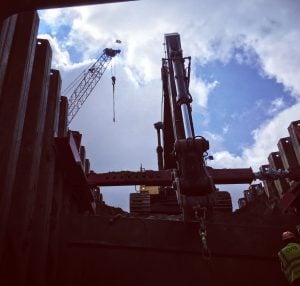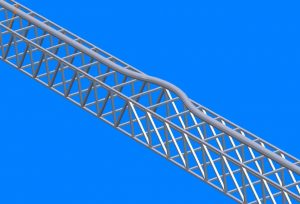Proper Connections Play a Critical Role in Scaffold Safety
Do you have the right connection? That is, are you attached correctly? We connect with people, we connect with busses and trains and planes, and we connect electrical cords with outlets. You have a lot of experience with connections but how good are you with scaffold connections? And I’m not just talking about connecting with scaffold people. I’m talking about mechanical connections, those attachments that make scaffolds, hoists, and other construction equipment work.
Am I serious? Am I worried about connections? You bet I am. A missed connection can mean injury or death. Take, for example, the simple connection involving a cross brace and the stud on a frame scaffold. If not connected, do you know that it can decrease the capacity of the scaffold by as much as 50 percent? What if you wire the cross brace to the frame leg because the stud is missing? That works just as well, doesn’t it? After all, it looks the same—sort of. However, to a properly trained eye there is a big difference.
The importance of connections is not based on size. While there should be no question that it is important to use the correct brace to connect a material hoist to a structure, and typically that brace is of significant size, what may be overlooked are those small things called bolts. A bolt is a bolt isn’t it? Go down to the local hardware store and pick up a couple bolts; better yet, go the big box store because the bolts are cheaper. (You may want to think about why they are cheaper!) Although you followed the manufacturer’s advice for the brace, you chose to ignore it when it came to the bolts. After all a bolt is a bolt or at least until the bolt breaks and the hoist comes tumbling down.
Sometimes the connection doesn’t appear to be a connection. Take for example, a scaffold inside a power plant boiler. The boiler has four sides, a bottom and a top, constructed of steel. Basically it’s a big box, with dimensions, for example, of 150 feet high, 60 feet wide and 100 feet long. The scaffold can be constructed so the boiler walls can be used as the bracing for the scaffold. The connections are frequently a bump connection with one end of a scaffold tube butted against one wall while the other end is butted against the opposing wall. This works well until someone who isn’t behaving removes a portion of the tube. Down comes the scaffold, as it has done on any number of occasions over the last decade or so. Luckily the scaffold wedges itself between the walls and the disaster is minimized, to the relief of many. Can you imagine the worker who removes the tube and the surprise he gets? Too bad he didn’t understand the connection.
What about the connection made with a scaffold coupler or clamp — same difference. Did you know that you can over tighten it? Obviously if you don’t tighten it enough the clamp will just slide on the tube. But if you over tighten it, you can distort the clamp, damage the tube, or break the clamp. So much for tight is good, tighter is better. And speaking of clamps, if you use a distorted clamp, the results will end unhappily, particularly if you are relying on it for your life.
Even rolling scaffolds, also known as mobile scaffolds, have critical connections; often the user never knows it until things go awry. While riding mobile scaffolds is never recommended, it happens. And if you choose to do it, you better be aware of your connections. One of the most critical connections is the pin that holds the caster in the scaffold leg. If you don’t do anything else correctly, pin your casters or your next connection will be with the ambulance taking you to the hospital. The next critical connection is the pin that holds scaffold legs from separating. Don’t forget this connection. Use the pin the scaffold supplier recommends; pens and pencils don’t work very well.
Connections aren’t limited to supported scaffolds. There are plenty of suspended scaffold connections that are crucial to one’s ability to cheat death. Take the wire rope as an example. Workers trust their lives to little clamps that when installed improperly will result in a rather suspenseful end. One would think that more thought would be given to the type of clamp being used on the rope that’s holding you from the last fall of your life. But erectors casually install the clamp incorrectly, failing to tighten the nuts to the correct torque and then not inspecting them before each workshift. Then they wonder why they failed. Luckily they are wearing fall protection that keeps them from falling to their deaths – assuming they made a correct connection to their lifelines!
Don’t ignore the connections. Or as the saying goes: “the devil is in the details.” If you don’t pay attention to the details, you may be seeing the devil sooner than you want.













